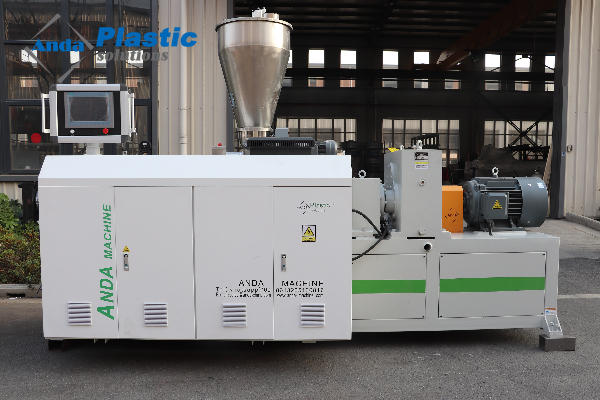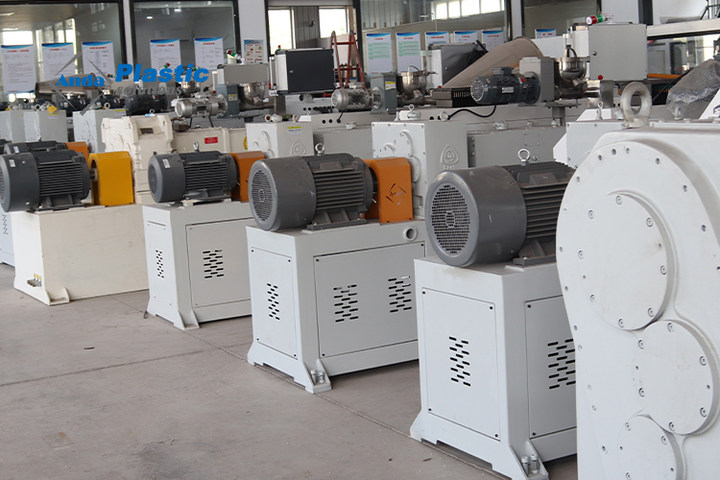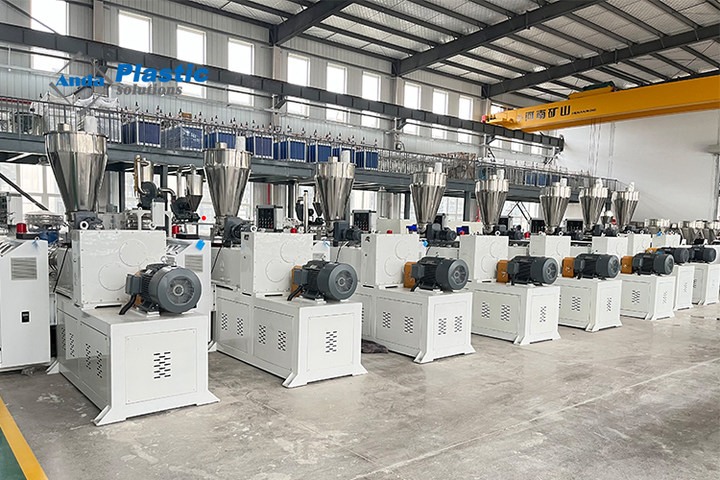Welcome to ANDA
PVC EXTRUDER OPERATION PTOCESS SECTION TWO

Power on
1. Confirm again whether the temperature of the extruder is normal. After the temperature of the mold reaches above 150°C, re-tighten the fastening screws and bolts of the mold and readjust the wall thickness adjustment screws to make the die gap more even and well-proportioned;
2. After the host temperature reaches the set temperature and heat preservation last for 30 minutes.Take machine that can produce normally for example, in order to prevent the material from decomposing in the barrel, the machine can be started slowly when the host temperature is 10°C~20°C lower than the actual production temperature, then turn on the machine’s main engine oil pump, lubrication, cooling system and water system;
3. After confirming that the synchronization, screw and feeding speed knob of the main motor are all at the position of zero or the minimum position, start the main motor and accelerate slowly and evenly to about 5RPM. (RPM: revolution per minute)
4. Start the feeding motor of the feeding system, and make the feeding revolution run at a lower speed than the screw revolution, so that the feeding process is in a "demanding" state.
5. Depending on the size of the main motor, increase the host and feeding speed appropriately. When increasing the speed, pay close attention to the current changes. To avoid excessive current when accelerating, first increase the host speed and then increase the feeding speed. Take 5-10 revolutions for main motor per minute at first startup, and 3 to 6 revolutions per minute for the feeding part. At the same time, pay close attention to the changes in the host current and various changes of dash boards: the starting current of the 90 machine cannot exceed 60A; the starting current of the 65 machine cannot exceed 40A; the starting current of the 55 machine The starting current cannot exceed 30A to avoid excessive pressure and damage to the machine. After the material comes out from the mold mouth, the speed can be slowly increased and the current amount can be increased appropriately.
6. Check whether the material is discharged evenly, and adjust the material wall thickness evenly.
7. When the mold mouse discharges are uniform and the plasticization is good, it can be pulled into the shaping sleeve. The degree of plasticization needs to be judged based on experience. Generally, it can be judged based on the appearance of the extruded material, that is, the surface is shiny, non-foaming, impurities-free and uncolored. If the extruded material is stretched by hand to a certain level without burrs and cracks and at the same time it has a certain elasticity and strong stretchability, it indicates good plasticization of the material. If the plasticization is not good, the temperature of the formula, barrel, and die can be adjusted appropriately to meet production requirements.
8. Observe the plasticization condition of the material from the exhaust vent, turn on the water inlet switch of the vacuum pump promptly and start its motor to vacuumize the material in the barrel.
9. When the die discharge is uniform and the plasticization is good, use a knife to cut a small circular hole directly above the tube and insert the tube into the sizing sleeve. At the same time, turn on a small amount of cooling water and turn it on. Cool, and after the tube comes out of the sizing sleeve, use a hook to connect the tube and the traction tube together.
10. Start the hauling machine and quickly adjust the pulling speed to the appropriate speed (when small-diameter pipes do not need traction, estimate the pulling speed in advance and start the machine, and then directly pull the tube from the sizing sleeve to the tractor manually, and then adjust its speed).

11. Close the lid of the cooling water tank, turn on the water pump and vacuum pump, cool the tube embryo in the water tank and maintain the vacuum degree in the water tank at 0.02~0.04Mpa.
12. According to the requirements of the product, adjust the coding content and other settings of the computer inkjet printer and start printing.
13. Start the cutting machine, gradually speed up the screw and feeding speed of the extruder until the production speed reaches the production speed requirements, and start normal production.
14. During the progress of normal production, the number of unpackaged products on the tube rack shall not exceed the following amounts:
a. When packaging tubes of which diameters are 75mm and 110mm, 5 tubes for one pack; and of which diameters are 160mm and 200mm, 3 tubes for one pack.
b. When wrapping with packaging rope, all product packaging ropes must not exceed 1.5 bundles.
15. For safety reasons, during normal production, the operator must operate in the front of the extruder. No one is allowed to touch the movable parts of the machine with own body.
16. Measurement and packaging records:
16.1 Use vernier calipers to measure the outer diameter, wall thickness, shape and length of the tube embryo. And adjust the extruder operating conditions to control the size within the standard range. The wire pipe needs to use a grip pipe spring to test if the inner hole meets the requirements.
16.2 Take a sample and compare it to make sure the color of the pipe is consistent with the sample; weigh the pipe and make it within the standard range; and conduct a simple physical property test to see if the wire pipe is constantly folded in half and the drainage pipe pedal is brittle or not, etc.).
16.3 Take samples according to actual needs and submit them to quality control for further physical property testing.
16.4 Record operating conditions and data archiving.
16.5 Arrange packaging workers to pack according to packaging specifications and record production capacity.

Inspections and precautions during operation
1. Pay attention to whether the current change of the extruder host is stable. If there exists large fluctuations, the feeding amount should be reduced. After the current is stable, the feeding amount can be slowly increased. If the feeding amount is reduced and the current remains high, the machine should be stopped for inspection.
2. Check whether there are any abnormal sounds in the gear reduction box, the main motor and other transmission parts.
3. Check whether the fasteners are loose and whether there is any abnormal vibration during operation.
4. Check the oil temperature in the gear reduction box. The oil temperature should generally not exceed 60°C.
5. Check whether the temperature control, cooling system, lubrication and vacuuming systems of the main engine and auxiliary engine are operating normally.
6. Observe whether the extruded material from the extruder is stable and uniform, and whether there are phenomena such as poor plasticization, overheating, discoloration, and unstable head pressure;
7. Keep records of the extruder’s temperature, pressure, host speed, feeding speed, host current, vacuum and other process parameters;
8. Keep working table clean and tidy.

Shut down
1. Normal shutdown
1) First, turn off the switches of each heating unit of the main machine barrel;
2) Close the discharge port of the hopper or adjust the feeding speed to "zero" and press the motor stop button;
3) Turn off and clean the main vacuum pump;
4) Gradually reduce the speed of the main machine screw, and after emptying the material in the barrel as much as possible, adjust the main machine screw speed to the "zero" position (if necessary, add cleaning material first and wait for the cleaning material to come out of the die).
5) Remove the mold and clean the material in the mold in time.
6) Start the screw again. After the material in the barrel is squeezed out, adjust the speed to the "zero" position, and turn off the oil pump, lubrication, cooling system, water system and main power supply of the main machine;
7) Close the water system, air system and related motors of various parts of the auxiliary engine;
8) Stop the printing action of the computer ink jet printer, turn off the power, and clean the print head with special cleaning agent;
9) Turn off the power of the auxiliary machine.
2. Abnormal shutdown (shutdown caused by accidents such as power outage):
After shutdown, the screw and feeding speed of the host should be quickly reduced to "zero", and the switches of each heating unit and other auxiliary systems should be turned off. After the fault is resolved, press Start the machine according to the normal startup sequence. If the shutdown time is long, you need to remove the mold, clean it, reinstall the mold, and then start the machine.
3. Clean the auxiliary machinery of the extruder and keep the area around the machine clean.
